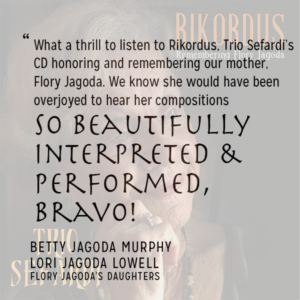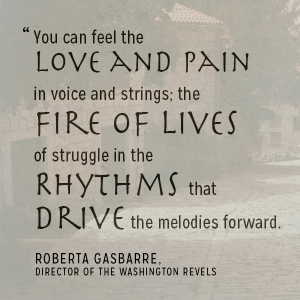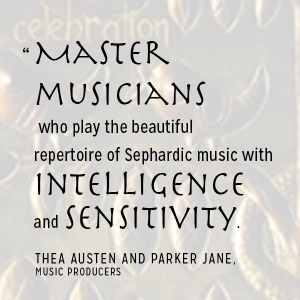(5) Esta Montanya d’Enfrente
This is another song we learned from the singing of Ike Azose. There exists at least one other Sephardic song with the exact same lyrics but a completely different melody. Ike remembers this version from Saturday evening parties held in his parents’ home while he was growing up. Friends and relatives from Sephardic communities of Turkey, who had immigrated to Seattle, would gather to sing, dance, and feast. It is not unusual in the Sephardic repertoire to find various versions of songs with the same or similar texts set to different melodies, or to find common melodies with completely different texts; this is of course true in many other traditional song repertoires.
Source: Isaac Azose
(8) Ken Es Esto?
This song comes from the repertoire of our beloved Nona, Flory Jagoda, whose introduction to singing songs in Ladino came from her own Nona (grandmother) in the village of Vlasenica, Bosnia. Flory says that the women of her village loved sad, romantic songs, “mushy ones,” in her words. The first verse of this song asks, “Who is this in the window/Showing me so much love?” and continues, “It could be the morning stars/Or the eyes of my beloved.” Indeed, the topics of traditional Sephardic repertoire of secular songs are no different from those of most secular folk music, encompassing love, courtship, marriage, history, holidays, and the whole range of human activities and emotions. One key difference between the Sephardic song tradition and that of many other cultures is that women played such a vital and widely acknowledged role in the making and perpetuating of the repertoire. A mother or grandmother sang the songs, and the little girls listened, learned, and remembered, as Flory experienced as a child in the home of her own beloved Nona; and Flory’s daughters (and one son) are also part of this “singing stream.” Despite the emphasis placed on the singing of Sephardic music, it is clear that instruments were used when they were available. Some of Flory’s aunts played guitars, and she began her musical life by playing accordion. Tina plays “Ken es esto” on bass viola da gamba, an instrument more commonly used to play music of the Renaissance and baroque eras.
Source: Flory Jagoda, The Flory Jagoda Songbook: Memories of Sarajevo (Owings Mills, MD, Tara Publications, 1993)
(12) Mi Suegra la Negra
There are many wedding songs in the Sephardic repertoire and within that genre are songs about in-laws. Most are complimentary to the in-laws, or at least advise the bride or groom to give great respect to their new in-laws (for a good example, listen to “Oildo mi novia” on Trio Sefardi’s first CD, “Sefardic Celebration). This song, however, is an unusually nasty example, in which the lyrics suggest that the mother-in-law is a devil with a black heart. Levy notes that this version of the song was collected in Filipópoli, or Filibe, a town in Bulgaria (as best as I can tell—Internet sources are unclear). There are several interpretations of this song on YouTube, and at least one contemporary setting for soprano and chamber ensemble.
Source: Levy, Chants Judeo-Espagnols (see song #3)
(15) Paxarico/Era Escuro/Puncha, Puncha
This instrumental medley comprises songs from the Balkans. “Paxarico” is believed to have come from Sarajevo, attributed by the ethnomusicologist Isaac Levy. All three of these songs can be found in his collection, Chants Judeo-Espagnols.
Source: Levy, Chants Judeo-Espagnols (see song #3 )




